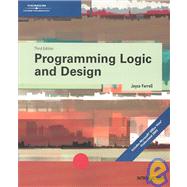| PREFACE | xi | ||||
| CHAPTER ONE An Overview of Computers and Logic | 1 | (34) | |||
|
2 | (3) | |||
|
5 | (5) | |||
|
6 | (1) | |||
|
6 | (1) | |||
|
7 | (1) | |||
|
7 | (1) | |||
|
8 | (1) | |||
|
9 | (1) | |||
|
10 | (2) | |||
|
12 | (4) | |||
|
16 | (2) | |||
|
18 | (2) | |||
|
20 | (1) | |||
|
21 | (1) | |||
|
22 | (2) | |||
|
24 | (2) | |||
|
26 | (1) | |||
|
26 | (3) | |||
|
29 | (3) | |||
|
32 | (3) | |||
| CHAPTER TWO Understanding Structure | 35 | (38) | |||
|
36 | (1) | |||
|
37 | (7) | |||
|
44 | (6) | |||
|
50 | (2) | |||
|
52 | (7) | |||
|
59 | (5) | |||
|
59 | (1) | |||
|
60 | (4) | |||
|
64 | (1) | |||
|
64 | (1) | |||
|
65 | (3) | |||
|
68 | (5) | |||
| CHAPTER THREE Modules, Hierarchy Charts, and Documentation | 73 | (40) | |||
|
74 | (3) | |||
|
74 | (1) | |||
|
75 | (1) | |||
|
75 | (1) | |||
|
76 | (1) | |||
|
77 | (4) | |||
|
81 | (1) | |||
|
82 | (2) | |||
|
84 | (2) | |||
|
86 | (1) | |||
|
87 | (7) | |||
|
94 | (5) | |||
|
99 | (2) | |||
|
101 | (1) | |||
|
101 | (2) | |||
|
103 | (3) | |||
|
106 | (7) | |||
| CHAPTER FOUR Writing and Designing a Complete Program | 113 | (36) | |||
|
114 | (4) | |||
|
118 | (11) | |||
|
118 | (5) | |||
|
123 | (1) | |||
|
124 | (1) | |||
|
124 | (5) | |||
|
129 | (3) | |||
|
132 | (2) | |||
|
134 | (1) | |||
|
135 | (2) | |||
|
137 | (1) | |||
|
138 | (2) | |||
|
138 | (1) | |||
|
139 | (1) | |||
|
139 | (1) | |||
|
140 | (1) | |||
|
141 | (1) | |||
|
141 | (1) | |||
|
142 | (3) | |||
|
145 | (4) | |||
| CHAPTER FIVE Making Decisions | 149 | (54) | |||
|
150 | (2) | |||
|
152 | (4) | |||
|
156 | (10) | |||
|
161 | (2) | |||
|
163 | (1) | |||
|
164 | (2) | |||
|
166 | (8) | |||
|
167 | (3) | |||
|
170 | (2) | |||
|
172 | (2) | |||
|
174 | (4) | |||
|
176 | (2) | |||
|
178 | (2) | |||
|
180 | (2) | |||
|
182 | (8) | |||
|
190 | (1) | |||
|
191 | (1) | |||
|
192 | (4) | |||
|
196 | (7) | |||
| CHAPTER SIX Looping | 203 | (42) | |||
|
204 | (1) | |||
|
204 | (3) | |||
|
207 | (4) | |||
|
211 | (2) | |||
|
213 | (1) | |||
|
214 | (3) | |||
|
214 | (1) | |||
|
214 | (1) | |||
|
215 | (1) | |||
|
215 | (1) | |||
|
216 | (1) | |||
|
217 | (2) | |||
|
219 | (4) | |||
|
223 | (1) | |||
|
224 | (6) | |||
|
230 | (3) | |||
|
233 | (1) | |||
|
233 | (1) | |||
|
234 | (5) | |||
|
239 | (6) | |||
| CHAPTER SEVEN Control Breaks | 245 | (40) | |||
|
246 | (1) | |||
|
246 | (6) | |||
|
252 | (2) | |||
|
254 | (2) | |||
|
256 | (5) | |||
|
261 | (6) | |||
|
267 | (6) | |||
|
273 | (1) | |||
|
274 | (1) | |||
|
275 | (5) | |||
|
280 | (5) | |||
| CHAPTER EIGHT Arrays | 285 | ||||
|
286 | (1) | |||
|
286 | (1) | |||
|
287 | (10) | |||
|
297 | (2) | |||
|
299 | (3) | |||
|
302 | (2) | |||
|
304 | (2) | |||
|
306 | (4) | |||
|
310 | (2) | |||
|
312 | (2) | |||
|
314 | (4) | |||
|
318 | (1) | |||
|
318 | (1) | |||
|
319 | (4) | |||
|
323 | ||||
| APPENDIX A Solving Difficult Structuring Problems | A-1 | ||||
| APPENDIX B Understanding Numbering Systems and Computer Codes | B-1 | ||||
| APPENDIX C Using a Large Decision Table | C-1 | ||||
| GLOSSARY | G-1 | ||||
| INDEX | I-1 |








